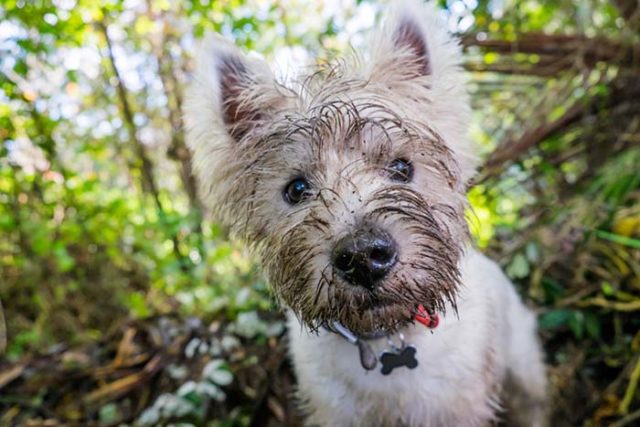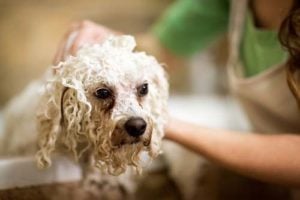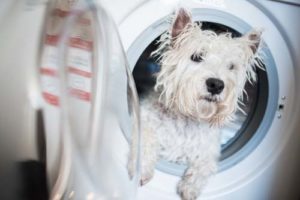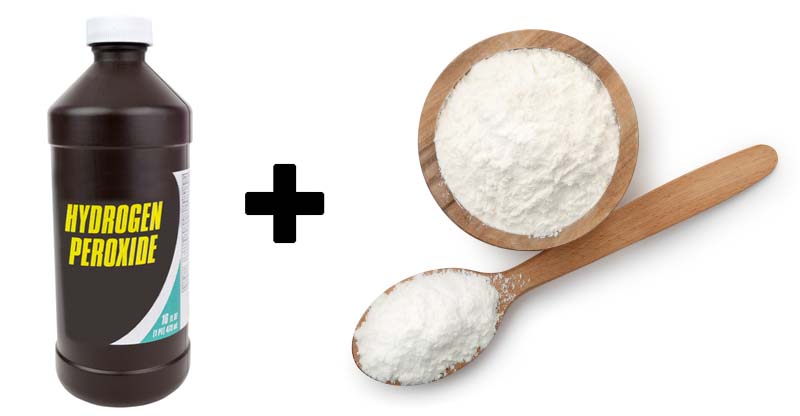
Table of Contents
All dogs have a tendency to get dirty because, well, they're dogs. And dirt on pups with white fur will often be the most visible because they stain easily and require more frequent grooming.
The constant upkeep can become tiring for both the owner and the dog. Keeping your pooch clean and stain-free is not only to make sure they look their best but is also a way to prevent debris and bacterial growth.
Cleaning a white dog's coat is not always an easy process, especially when they have managed to attract anything and everything deep into their fur.
White dog fur cleaning can become even more difficult if the stain was left sitting there. This is why it's vital that the dog is washed as soon as possible and the below step-by-step system is followed.
How to Remove White Stains From Your Dog
Step 1
 The very first step is to wash the pup with a whitening shampoo (like this one). Be careful to avoid getting the shampoo or water in the dog’s eyes while lathering them up. Focus more on areas that have darker stains, while shampooing lighting over areas that are not showing signs of staining.
The very first step is to wash the pup with a whitening shampoo (like this one). Be careful to avoid getting the shampoo or water in the dog’s eyes while lathering them up. Focus more on areas that have darker stains, while shampooing lighting over areas that are not showing signs of staining.
Lather up the areas such as the muzzle, chest, and tail to allow a protection layer against new stains. Let the shampoo sit on the dog – especially on the dark stains – for two to five minutes, and soak into the hair of the dog for the best results.
Step 2
Rinse the dog thoroughly with warm water, making sure to remove all shampoo from their coat. To double-check, run your fingers through their coat as they are being rinsed to guarantee that all shampoo has been rinsed off the first go-around. A second rinse may be necessary if they have a thicker coat or if areas were missed.
Step 3
After the shampoo has been completely removed from the dog’s fur, apply a dog hair conditioner on your pooch while avoiding their ears, eyes, and mouth.
The conditioner will add a layer of protection to white hair and will prevent the hair from absorbing new stains. The dog will need to be rinsed with warm water again and should be removed from all excess conditioner in their fur. Dry the dog until they are only damp with a clean towel.
Step 4
An important step in making sure that the dog has been properly groomed and the stains have all been removed is brushing through their fur with a pin brush or slicker brush (depending on their coat type). Pin brushes are good to use on dogs with long or thick coats. A slicker brush is the best to use on dogs with finer or more sensitive skin.
Brush thoroughly where the dark stains on his white fur were located and where stains frequently collect. Also, brush in the direction of the fur growth to remove the coat of any tangles. Start from their head and work your way down their body to their tail.
Step 5
This step consists of creating a hydrogen peroxide and cornstarch paste. The paste should be applied to the dog’s stained fur spots and massaged gently into its coat. If the dog has thick, long white fur, it may be necessary to use a comb to drag the paste to the base of the fur.
Let the paste sit for five to fifteen minutes, depending on the severity, darkness, and depth of the stain. Rinse your pup's coat with warm water and brush the stained areas to remove any lingering debris. Dry their coat with a clean, absorbing pet towel.
Step 6
Once the stains are mostly removed from the dog’s coat, trim sections of the dog’s coat that are common places for brown stains to show up. These areas can include the dog's muzzle and chest. Trim them with thinning shears by clipping a tiny amount of hair and then taking a step back to check the work done.
Remember not to trim too close as this can potentially irritate their skin and cause additional problems. Repeat until desired length or style is accomplished. You don't need to give the dog a full haircut, but this type of slight trim will ease the process of getting current stains out of white dog fur, and also prevent future ones.
Step 7
If, after all, six steps above, the stain persists and trimming the dog's hair is not an option, repeat the entire process the following day or once a week until you have the desired results. It is not recommended to continuously wash the dog because it caused dry skin and brittle hair, but it is okay to have frequent washes if it does not occur often.
The best course of action is to repeat the process specifically focusing on the dark stain(s) on white fur, once weekly until the stain(s) is completely removed from the fur, and to continue using the method as a monthly stain deterrent and treatment.
Step 8
Identify the origin of the stains and eliminate them if possible. Stains that are acquired outdoors may not be preventable, but if they are consistently getting into something indoors or within the yard, remove it from the reach or routine. The best way to treat stains is to prevent them.
Tips and Tricks
Sometimes dark brown stains can be nearly impossible to remove from white dog fur or the pet may be extra sensitive to ingredients that are normally used in stain removal. That is okay as there are safe alternatives to the usual method of stain removal that works just as efficiently but may be more time-consuming and involving.
 Other common methods include using white vinegar and hydrogen peroxide on the affected areas. Fur stain removers and whitening shampoos are also available for purchase at most pet stores and online (this one, for example).
Other common methods include using white vinegar and hydrogen peroxide on the affected areas. Fur stain removers and whitening shampoos are also available for purchase at most pet stores and online (this one, for example).
Dog fur stain removers and heavy chemicals should be a last resort, however, and should not be used unless the basic method of dog washing, grooming, and natural products has failed. Even then, a trip to a professional groomer may be necessary for the proper use of heavier products and to effectively remove the stains. There are also recipes available for whitening shampoo if you would like to go with an all-natural product.
READ NEXT: 9 Ways to Improve Your Dog’s Skin and Coat Health
Disclosure: We may earn affiliate commissions at no cost to you from the links on this page. This did not affect our assessment of products. Read more here and find full disclosure here.













